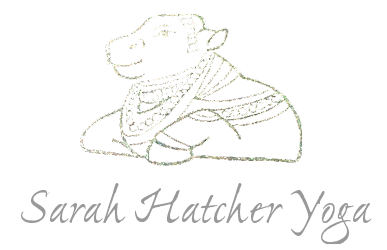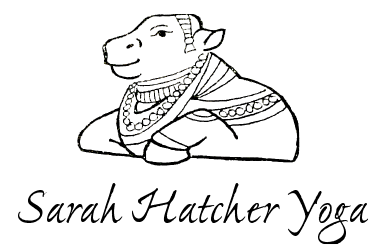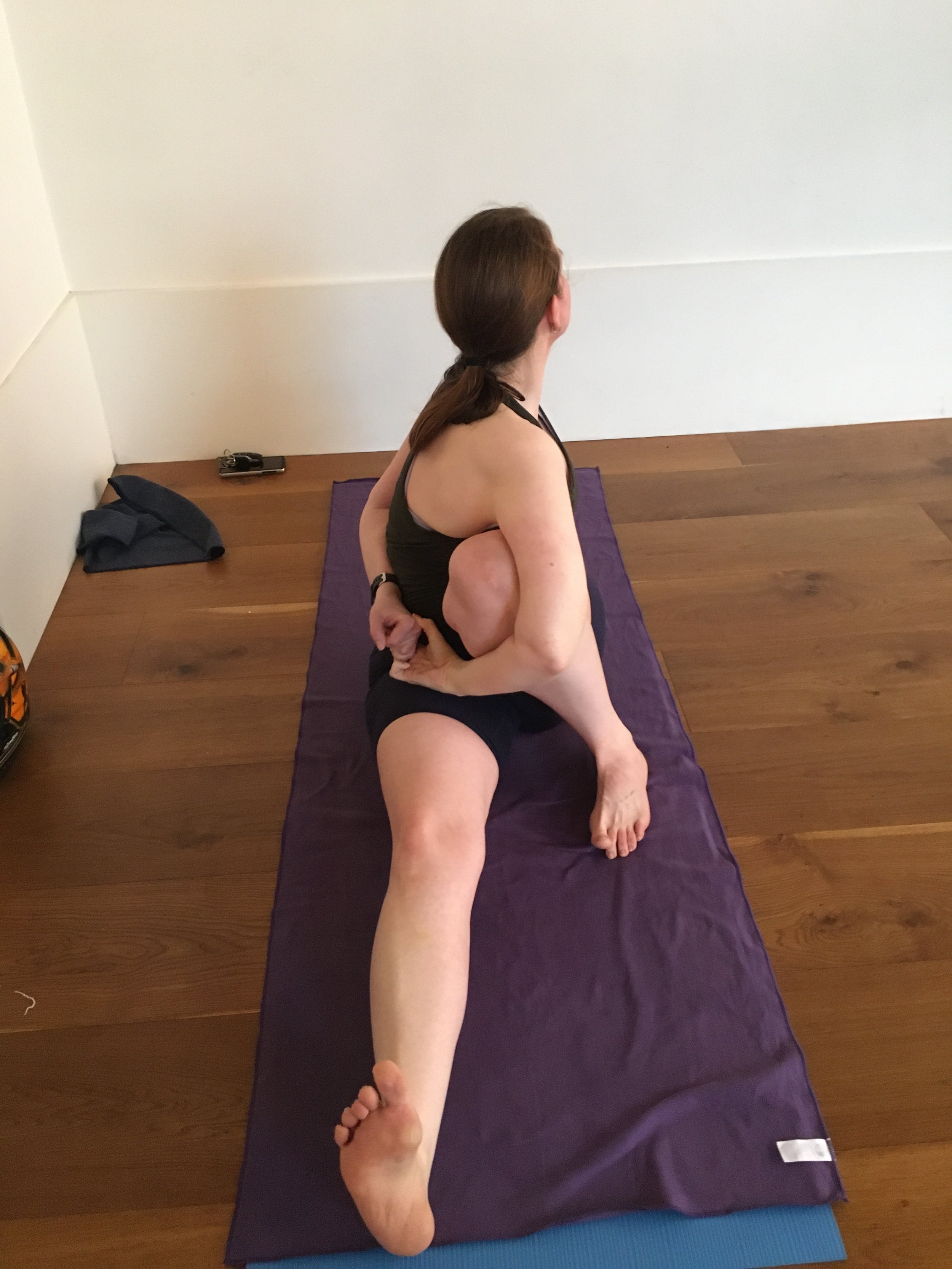And now, introducing the Intermediate Series, Irish yogis!
My dear student and friend Josephine Ryan - you can find her teaching in Co Offaly and at @joyoga_yoyofyoga on Instagram
This week marks my fourth year of teaching in Ireland!
I want to thank Amy Kokoszka for offering me the opportunity to teach at her studio the Rathmines Collective: her knowledge of hatha and ashtanga yoga is beyond exceptional; anyone who has been to her classes or practiced next to her have seen her devotion and grace and been awed by her magnificent breath! Thank you Amy!
I also want to thank Rionach Flynn and Gillian Mooney, to Suzanne and John - here in Dublin - to Fiona and Martin in Galway, and to Gabriella Nicholson in Belfast and Euncie and Eamon in Cork; these yoga teachers have recommended my teachings to their students and shared my events. Thank you for your support over these last four years - being new here to Ireland, I didn’t know many people at all, and your support and sharing really helped me get started here.
I taught my first classes at Amy’s studio in March of 2020. This was just before covid; I think I taught for a week or so before the world shut down. I then moved all of my teachings online like most of us teachers did - offering free online classes, pop-up events, live chanting events and led and Mysore classes from home. When Amy closed the RC, I took my in-studio offerings to Little Bird Coffee and Yoga as I found the studio was the right size (can fit 18 tight); I found that Eileen and Elena run a fantastic center, and the LB is a beautiful space with great light and a lofty feeling of quiet, comfort and ease.
I am now at the two-year mark of teaching at LB. I have never let the online go - it has become my bread and butter as an ashtanga yoga teacher: I have taught students from all over Europe and reached a few rural yogis here in Ireland who come as well. I won’t let this asset go, all my classes are to remain online!
After four years of observing, teaching and participating in the yoga scene in Ireland, I’d like to share what I have seen and share what I could see more of…I could see a few more students practicing the intermediate series! May this blog post inspire you to add a little kindling to the fire of your practice, be courageous and brave, and begin the Intermediate Series. I’d be delighted to help you along with this series. May the rest of this blog explain why.
[Of course if you are brand new to Ashtanga Yoga - looking for a teacher or a programme to start - I also teach the primary series to all new students. Please don’t take this specific blog post that I only want to teach intermediate - I love all the series and will take the time and great care needed to support you in your beginning yoga journey.]
**
Since 2019, the strict, hard rules of ashtanga yoga have died a great death. Some old rules are still accepted in the mainstream ashtanga yoga world, however there are many ashtanga teachers like myself who continue to follow some of the traditional rules, however we bend a few more. Let’s look at what rules we do want to hold on to and some that could just go away.
To start, there is a standard in practice that in order to move forward into the intermediate series, one has to:
1), bind their hands in Marichyasana D,
2), bind their hands in Supta Kurmasana, and
3), come up to standing from Urdhva Dhanurasana from the floor.
Without the support of the intermediate series, it is difficult to build the strength and stamina to come up from the floor in a backbend to standing without the help of the first seven postures of intermediate. And, we all know that binding a posture - any posture really, however specifically Marichyasana D and Supta Kurmasana, doesn’t make the posture complete. What makes the posture complete is a steady breath, done without strain and with ease. This said, it doesn’t matter if you bind or not, what matters is that you have approached these poses with specific determination and have found ease and comfort in them by maintaining a steady breath.
These rules of achieving great awareness in these three pillar-posutres is quite sensible because having an established primary series will give students the base and stability to tackle such difficult postures as Kapotasana and Dvi Pada Sirsasana - gatekeeper postures nestled in the Intermediate Series.
Yet I have seen that students feel that they have to have these completions done to perfection in order to move into the intermediate series; here is where bending these rules is good practice.
Attempting to get that bind in Marichy D, those hands bound in Supta K and getting that backbend solidified will make the journey into Intermediate easier, however we don’t want to stay in Primary series so long that we feel weighted heavy or altogether bored and later, quit ashtanga altogether!
Another rule which isn’t best for everyone (some people need this, however not everyone) is that a student needs to add on the next series after primary series. This means the students’ practice becomes very long and arduous. This isn’t practical for a parent or someone who only has an hour and a half every morning before work. And this definitely isn’t practical for someone who is older and practices. Once one is proficient in primary, do the intermediate series to the best of their ability. And perhaps it is shorter version in the beginning (not as long as say doing full primary), however it is done with fluid teachings: i.e. just practice the first seven postures of intermediate with lots of Urdhva Dhanurasana in order to feel comfortable and stable to approach Kapotasana skilfully and then move on to the next one.
Why do the intermediate series once there is proficiency in primary?
The answer is that the apanic (downward flow of energy) quality of primary - all the forward bends which you go into via the exhale breath - create a heaviness in the body if done too long and without the pranic (upward flow of energy) quality of intermediate.
The intermediate series is the yang which supports this yin; we inhale to come into the posture in the Intermediate Series (not always but usually). This balancing of energy will replenish the nervous system and balance the apanic practice of primary.
Also there are less jump backs and more strength and flexibility based postures in the intermediate series, however nothing beats all those strength based seated jump backs in primary! So they balance each other out quite nicely.
When you are starting the intermediate series or primary series, whether you’re a beginner or a seasoned practitioner, don't forget about these hidden gems: these will help you along your dedicated yoga path!
-When you come to the shala, feel comfortable to start seated and begin with pranayama and chanting; when you come to standing to begin, chant the invocation;
-Practice and learn chakrasana (the back-wards roll out of asanas - this is a unique vinyasa that is tricky and may be lost and forgotten in twenty-years’time);
-Chant the Mangala Mantra (closing chant) softly to yourself at the end of practice or ask myself or Hannah to come next to you and we will teach it to you and chant it with you.
-Feel comfortable to receive adjustments; if there is any time that an adjustment isn’t safe or done without your consent tell your teacher right away;
-Give a thanks when leaving the Shala; a simple eye contact or gesture of thanks is a nice way to connect with your teacher and share a moment of gratitude for practicing in their company; they in return too can thank you for your hard work on the mat and your discipline and time spent with them.
**
These elements above make Ashtanga Yoga unique! Indulge in your practice and modify and adapt anywhere in the series; do a little bit or a lot; be yourself, show up on your mat diligently and be ready to learn.
Chant soulfully! Don’t be afraid to chant the shanti mantras from the soul of your being; chanting is integrous to the practice of yoga and though it is unusual at first, sit and listen and give it some time, it may be something you’ll enjoy. After four years of chanting the yoga sutras online on a Monday, very few people come. Please try to chant and give it a chance!
Ashtanga Yoga used to be coined a ‘research’ based practice; hence the name Ashtanga Yoga Research Institute (AYRI, the old name of the Shala in Mysore). It was always growing and expanding, there were postures added in and taken out. Now a-days it is a set method (no changes are being made to the series) however you as a practitioner can continue to adapt and modify and design your practice so that it serves you best.
May us ashtangis here in Ireland continue to practice mindfully together; by joining together and practicing together we join other people all around the world who continue to practice. Because we continue to practice, we join this global community. Notice how it only takes thirty minutes to have a calming, body-centering and mindful experience of yoga - it doesn’t have to be perfect. It doesn’t have to be a full series, just a simple breathing practice with a meditative mind on the breath.
Often the worst of my practices are the ones that teach me the most about myself.
The very worst practice is the one I don’t do.
Please feel welcome to join me on my retreats, join my online and Dublin-based Mysore programme (I teach Thursdays, Sundays and Hannah teaches on Tuesdays and we swap Fridays at Little Bird Coffee and Yoga), and join me online for pop-up led primary series classes, pranayama and chanting classes.
Join me the 14-19 July for a week of Mysore and Led Classes; this Dublin intensive is from 6:30-9:30 am Sunday through Friday and I would love to see you there.
For those of you who are not yet practicing intmediate series, please come to David Garrigues workshop here in Dublin 31 May - 2 June. You can register with me on my website and don’t miss an exceptional weekend to get started on your intermediate series journey. After all, the intermediate series supports the primary series and makes an ashtanga yogi a well-balanced practitioner.
Om tat sat.


